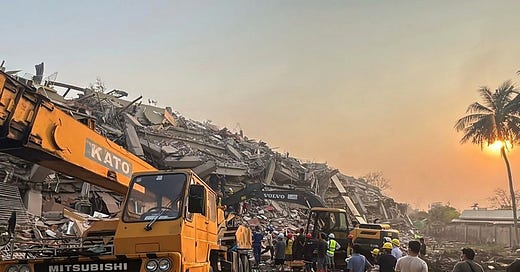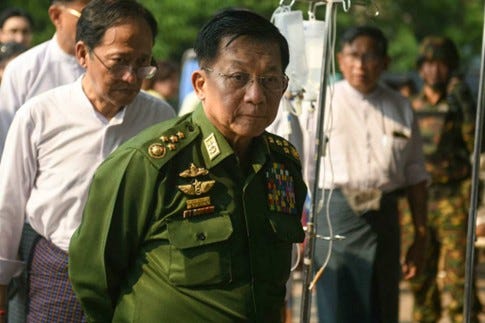War and Disaster in Myanmar
Junta continues air strikes while appealing for international aid
By: David Scott Mathieson
Myanmar’s catastrophic earthquake on March 28 has refocused international attention on the war-ravaged country. The 7.7 Richter scale quake which rocked central Myanmar has destroyed large parts of Mandalay, nearby Sagaing town, and the capital city of Naypyidaw, as well as many other parts of the Dry Zone and Southern Shan State, demolishing thousands of centuries-old religious structures. At least 3,000 people have been killed, and the death toll is certain to rise as rescue teams continue searching through debris. However, speculation about the earthquake being a prompt for a nationwide peace process is naively premature.
The dilemma will be how much the military regime permits the kind of assistance needed in a disaster of this scale, and crucially, how much the State Administration Council, as the junta is known, permits local organizations to operate and help their own people. The military fired on a Chinese aid convoy last night, but the reasons are uncertain, it could have been by mistake.
The junta has weaponized humanitarian assistance around Myanmar for years and there are widespread fears that they will control, divert or purloin aid once again, as the previous regime did following Cyclone Nargis, which killed 84,500 people in 2008, and after Cyclone Mocha devastated Rakhine State in 2023, killing 460 and leaving hundreds missing, most of them Rohingya refugees.
Senior General Min Aung Hlaing, the junta leader, responded with rare decisiveness, saying in a public address, “I have declared a state of emergency in all affected areas and have opened all possible channels to receive international assistance…I would like to invite any country or organization to come and assist the monks, nuns, and citizens in Myanmar who are in need.” Already, emergency rescue teams from Singapore, India, Russia, Malaysia and China have been deployed and are working alongside Myanmar Fire Department personnel.
The European Union has pledged €2.5 million (US$2.70 million), and the British government £10 million Sterling for emergency relief efforts. US President Donald Trump, uncharacteristically, pledged to help too, and the US government has since pledged US$2 million. This may be a solid start, and definitely welcome, but the ongoing humanitarian needs throughout Myanmar are immense, as cuts to the US Agency for International Development (USAID) have already affected the United Nations World Food Program. This doesn’t even take into account reconstruction costs, which will run into the billions.
There are so many dangers and hardships the population will face, as Myanmar’s already ramshackle infrastructure, limited electricity, and damaged water supplies will impact the hundreds of thousands of people now homeless. It is also the hottest time of the year in Central Myanmar, and with so many victims still buried under collapsing buildings, the possibility of spreading disease is ever present.
The challenges of rebuilding critical infrastructure in health and education, electricity and telecommunications, and rebuilding utterly devastated neighborhoods will be gargantuan. All of this will be severely hampered by a corrupt, brutal, and incompetent military junta intent on grasping onto power and impervious to the suffering of the people across Myanmar.
How will the earthquake recovery period impact the still raging civil war? The disaster struck the day after the annual Armed Forces Day parade, a powerful omen for the superstitious Min Aung Hlaing, and many in the military leadership. The tone during his speech was belligerent, urging the military to fight on in what he called a ‘Just War’ against terrorists waging ‘One-State One-Sword Warlordism.’
On multiple battlefields, it was business as usual after the quake. There have been credible reports that the SAC conducted airstrikes hours after the earthquake in Naungkhio in Shan State, although these were likely planned before the quake. Also credible reports that around 10 other targets were struck in several locations from Friday to end of Sunday, including attacks by one-man para-motor craft in Magway, 520 km northwest of the commercial capital /Yangon, and air and drone strikes against the Karen National Union (KNU) in Karen State, not in one of the worst affected quake areas.
The monitoring group Enemy Air Route (EAR), which tracks military aircraft movements, estimated some 66 individual takeoffs by a range of aircraft the day after the quake, and 44 on Sunday, but the majority of these were fixed wing transport aircraft or Mi-17 helicopters, and just several jet fighters or helicopter gunships. The Democratic Voice of Burma (DVB) has estimated around 20 airstrikes since the earthquake struck.
The opposition National Unity Government (NUG) announced a day after the earthquake that it “will implement a two-week pause in offensive military operations, except for defensive actions, in earthquake-affected areas starting March 30, 2025,” and pledged to work with international relief operations.
While it's a positive move that the NUG has called for a two-week suspension of offensive actions, the exiled government does not have effective command and control over all armed groups in Central Myanmar, and in recent months a number of People's Defense Force units have been publicly severing ties with the NUG so won’t be bound by any ceasefire or stand fast order. The important caveat that exempts ‘defensive actions’ will likely be tested as the SAC continues to attack throughout the conflict zones.
Other armed groups who are not under the NUG’s leadership have stopped short of calling for a ceasefire, including the Karen National Union (KNU) and the Three Brotherhood Alliance (3BA) who have all issued statements pledging support for relief operations, and the Karenni Interim Executive Council (KIEC) revolutionary body promised sanctuary for anyone affected by the earthquake. The Three Brotherhood Alliance today followed up with a “one-month unilateral humanitarian pause, refraining from offensive operations in areas of ongoing conflict, to enable swift and effective post-earthquake rescue efforts.”
Given the intensity of the conflict on multiple fronts, a complete de-escalation is unlikely, assuming that the SAC is in any way sincere about it.
The big question is to what extent the military’s capacity has been affected by the earthquake, including its facilities, storage of fuel and ammunition, manufacturing base in key cantonment cities such as Meiktila, and their ability to navigate damaged infrastructure such as roads and bridges. In short, how much has the regime’s war fighting ability been diminished, and how much more vulnerable is the military now?
An equally important question is how the anti-SAC forces take advantage of the disaster to drive home coordinated attacks, or take a pause.
David Scott Mathieson is an independent analyst working on conflict, humanitarian, and human rights issues in Myanmar and a regular contributor to Asia Sentinel





I don't know ... I'm not sure, David Scott Mathieson claims, that international attention has been re-focused on Burma following the earthquake. Gleaning the world's media, most people -- readers' especially -- seemed to be tuned in to the destruction the earthquake has wrought. And, sure, international aid has been coming in but nowhere near on the scale of other natural disasters, such as the 2004 Sumatra tsunami (what are, in the words of Charles Tilly, are "huge comparisons"). In so far as the military dictatorship's systematic carnage to lives and property, moves to bring down that regime appears to stem only from within Burma, spearheaded by various armed domestic groups. The historically and predictably lame ASEAN, filled with pure hot air, has categorically failed to rein in its member in Rangoon, while China keeps backing the cowardly junta with money and arms, mostly to ensure its invested economic interests are protected. The so-called promised pause in fighting came to nought: the junta cowardly struck at the warring parties on the other side as the world's eyes were gazed on largely the physical destruction of property from the quake. It seems to me there isn't a single state east, west, south or north of Burma -- not even the great big loud-mouth oaf Donald Trump -- is willing to cast its eyes beyond its nose to bring the civil war in Burma to an amicable conclusion quickly. The last thing you'd expect ASEAN members to do in the case of Burma is lift a useful finger. That's because it -- as a collective -- has zero power and influence over a corrupt, murderous military regime certain ASEAN member -- principally Singapore and Malaysia -- like China continue to invest in Burma -- investments that in real terms do not and have not lifted the plight of ordinary Burmese from their long-suffering wretchedness.